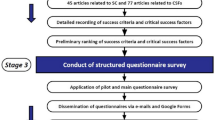Abstract
Improvement action to human resource (HR) in organization plays important role in determining the success of organization. Many studies have been done to discuss on how the organization may improve their HR performance. However, not many studies yet discuss the level of improvement that organization shall taken appropriately. Identification of organization’s priority level of improvement seems found to be a complicated work to do in most emerging organizations. High intangible and invisible variables and attributes contribute to unclear situations and perceptions in the organization itself. The complexity and limitation in tools and techniques, make each solution taken is less efficient and effective. Therefore, this study will discuss the development of Fuzzy Family_Marriage Deployment (FFMD) Pyramid. FFMD Pyramid is a new method for decision support in organization especially for HR by equally deploy dimension and variable of family and marriage to quality dimension and variable in organization then identify priorities by considering the deployment value (crisp value) and fuzzy value (non-crisp value) as decision support for organization to plan and decide proper improvement action with proper percentage (%) level of priority of improvement action. As result, a concise and simple pyramid shall present an informative yet effective and efficient to the decision maker to support their better decision especially with regard to the improvement action for HR performance. In addition, the Family_Marriage value that utilize in this study may bring about a new perspective that decision maker shall consider to support their decision process especially for the HR improvement action.
Similar content being viewed by others
References
Auh S., Johnson M.D.: Cross-cultural invariance of measures of satisfaction and service quality. J. Bus. Res. 57, 901–912 (2002)
Bourne M., Neely A., Platts K., Mills J.: The success and failure of performance measurement initiatives: perceptions of participating managers. Int. J. Oper. Prod. Manag. 22(11), 1288–1310 (2002)
Carlson D.S., Kacmar K.M, Zivnuska S., Ferguson M., Whitten D.: Work-Family enrichment and job Performance: a constructive replication of affective events theory. J. Occup. Health Psychol. 16(3), 297–312 (2011)
Carrasco R.V., Perez M.E.L., Centeno E.: A qualitative approach to the challenges for women in management: Are they really starting in the 21st century?. Qual. Quant. Int. J. 46(5), 1337–1357 (2012)
Chennell, A.F., Dransfield, S.B., Field, J.B., Fisher, N.I., Saunders, I.W., D.E. (2000). OPM: a system for organisational performance measurement. Presented at “Performance measurement—past, present and future”, University Of Cambridge, 19–21 July 2000
Comstock T., Dooley K.: A tale of two QFDs. Qual. Manag. J. 5(4), 32–45 (1998)
Cronbach L.J.: Coefficient alpha and the internal structure of tests. Psychometrica 16, 297–334 (1951)
Day, R.D., Gilbert, K.R., Sttles, B.H., Burr, W.R. (1995) Research and Theory in Family Science. Brooks/Cole Publishing Company, St. Paul
Day R.G.: Quality Function Deployment. ASQC Quality Press, Wisconsin (1993)
Goetsch, D.L, Davis, S.B.: Quality Management: Introduction to Total Quality Management for Production, Processing and Services, 3rd edn. Pearson Education, New Jersey (2000)
Herbert T.T.: Organizational Behavior: Readings and Cases. Macmillan Publishing Co., New York (1976)
Kaplan R.S., Norton D.P.: The Strategy-Focused Organisation. Harvard Business School Press, Boston (2001)
Lockarmy A., Khuruna A.: Quality function deployment: total quality management for new product design. Int. J. Qual. Reliab. Manag. 12, 33–41 (1995)
Looy, B.V.G., Gemmel, P., Dierdonck, V.R.: Services Management: An Integrated Approach. Prentice Hall, Edinburgh Gate (2003)
Neely A.: The performance measurement revolution: why now and what next? Int. J. Oper. Prod. Manag. 19(2), 205–218 (1999)
Neely A., Adams C.: The performance prism perspective. J. Cost Manag. 15(1), 7–15 (2001)
Nguyen, S.T., Yager, R.R.: Some research direction in Fuzzy Control. In: Theoretical Aspects of Fuzzy Control, pp. 302–307. Wiley, New York (1995)
Rampersad, H.K.: Total Performance Scorecard: Redefining Management to Achieve Performance with Integrity. Heinemann Business Books, Elsevier Science, Massachusetts (2003)
Rika Fatimah P.L., Jemain A.A.: QFD approach in determining importance of family performance: gender evaluation in Malaysia. Int. J. Popul. 13(2), 179–198 (2007)
Rika Fatimah, P.L., Jemain, A.A.: Quality perspective on women’s role in marriage: assessment on women’s satisfaction and work. In Nardi, V. (ed.) Chapter 9: Book of Feminism and Women in Leadership, pp. 155–167. Nova Science Publisher, New York (2010). ISBN: 978-1-61122-578-5
Rika Fatimah P.L., Ibrahim K., Jemain A.A., Mohamad Nasir S., Khairul Anuar M.A.: Quality_Family Deployment: a new perspective in determining priority importance for improving work performance in organization. Soc. Indicators Res. 92(1), 131–149 (2009a)
Rika Fatimah, P.L., Jemain, A.A., Khairul Anuar, M.A., Mohamad Nasir, S.: Quality_Marriage Deployment in determining priority needs for initiating marriage loyalty. Qual. Quant. Int. J. 43(3), 401–416 (2009b)
Rika Fatimah P.L., Doris Padmini S., Ibrahim K.: A new approach on measuring quality of marriage: the linkage between quality in organization with marital dimensions and variables. Int. J. Soc. Sci. Econ. Art 2(1), 74–79 (2012)
Sanchez J.A.L., Vijande M.L.S., Gutierrez J.A.T.: Value-creating functions, satisfaction and loyalty in business markets: a categorical variable approach using a robust methodology under structural equation modeling. Qual. Quant. Int. J. 46(3), 777–794 (2012)
Steenbergen E.F.V., Ellemers N.: Is managing the work–family interface worthwhile? Benefits for employee health and performance. J. Organ. Behav. 30(5), 617–642 (2009)
Woods R.C.: Managing to meet employee expectations: quality improvement tools narrow the gap between employee expectations and company resources. Human Resour. Plan. 16(4), 24–35 (1994)
Werther W., Davis K.: Personnel Management and Human Resources. McGraw-Hill, Tokyo (1982)
Zadeh L.A.: Fuzzy set. Inform. Control 8, 338–353 (1965)
Zadeh, L.A., Kacprzyk , J. (eds): Fuzzy Logic for the Management of Uncertainty. Wiley, New York (1992)
Author information
Authors and Affiliations
Corresponding author
Rights and permissions
About this article
Cite this article
Rika Fatimah, P.L. The development of FFMD Pyramid: Fuzzy Family_Marriage Deployment as decision support method to improve human resources performance. Qual Quant 48, 659–672 (2014). https://doi.org/10.1007/s11135-012-9793-1
Published:
Issue Date:
DOI: https://doi.org/10.1007/s11135-012-9793-1




